St. Patrick's Street: where to for Cork's most storied street?
In its long history of boom, bust, destruction and reinvention Patrick’s St has always been a contested space. But how will ‘Pana’ fare in its third century? T+D went on a walkabout to investigate.
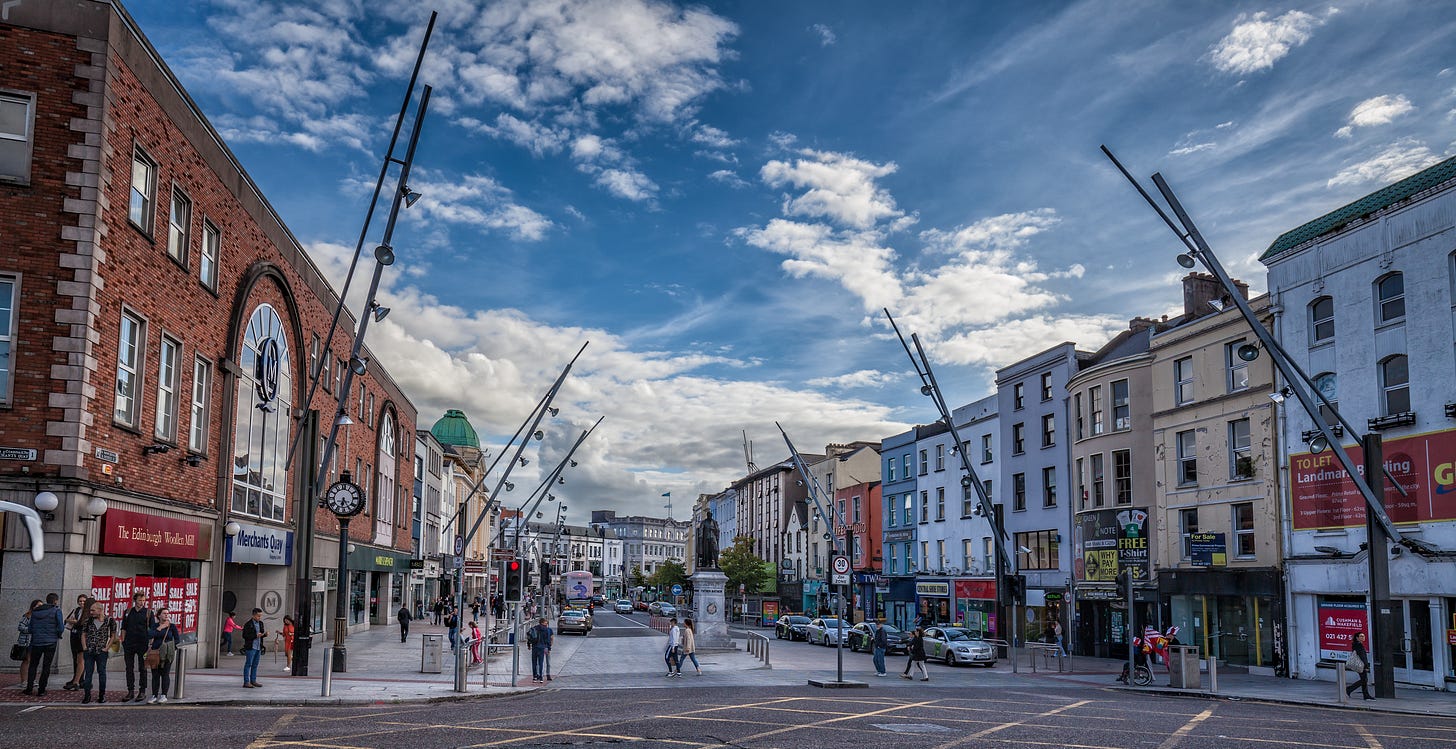
Two important historical facts play a significant part in understanding the direction St. Patrick's Street has taken over the course of its two centuries in existence.
The first, you might intuit, owing to the gentle meandering nature of the street: before it was filled in and concreted over, the street was a channel, through which the River Lee flowed freely. And second, for as long as it’s been in existence there’s always been a tension as to what function the street should primarily serve, and just as importantly, who it should serve, and how people should move around and through it.
In that forever low rumbling battle of commercial and ideological forces, the merchant princes of Cork, led first by the Freemen, a group of Protestants and mostly Tories, and latterly by big national and international retailers have been the dominant forces in shaping St. Patrick’s Street commercial identity. Into that mix has come Roches Stores and Dunnes Stores, Debenhams, Egans, Cashs (now Brown Thomas), Jack & Jones, The Moderne and many, many others. But once upon a time, the street was also home to the Savoy Cinema and the Pavillion, which between them could accommodate thousands of punters. There were also printing presses and art galleries on the street, hotels and hostelries and a rather famous little hut that passed from the city’s firemen to its bus drivers.
Today, there’s no cinema on the street. In fact, entertainment and hospitality outlets have a scarce hold on the street. Roches and Denenhams have both gone, as have the newspaper offices. On a recent walkabout I counted more than 15 vacant premises on Patrick’s Street, chief amongst them the vast Roches building which has been empty coming up on three years. It was put up for sale last year with a guide price of around €20 million.
So what’s to become of ‘Pana’ as it is affectionately known? Will retailers come back and fill out the street, but to the effect that it will become more or less like every other city centre high street throughout Europe with a mix of the same brand name stores selling the same brand name clothes? Or is there space for life beyond clothes, shoes and vape shopping? Such as cafes to sit and watch the Cork cosmos go by. Or a gallery. Or even a non-commercial space?
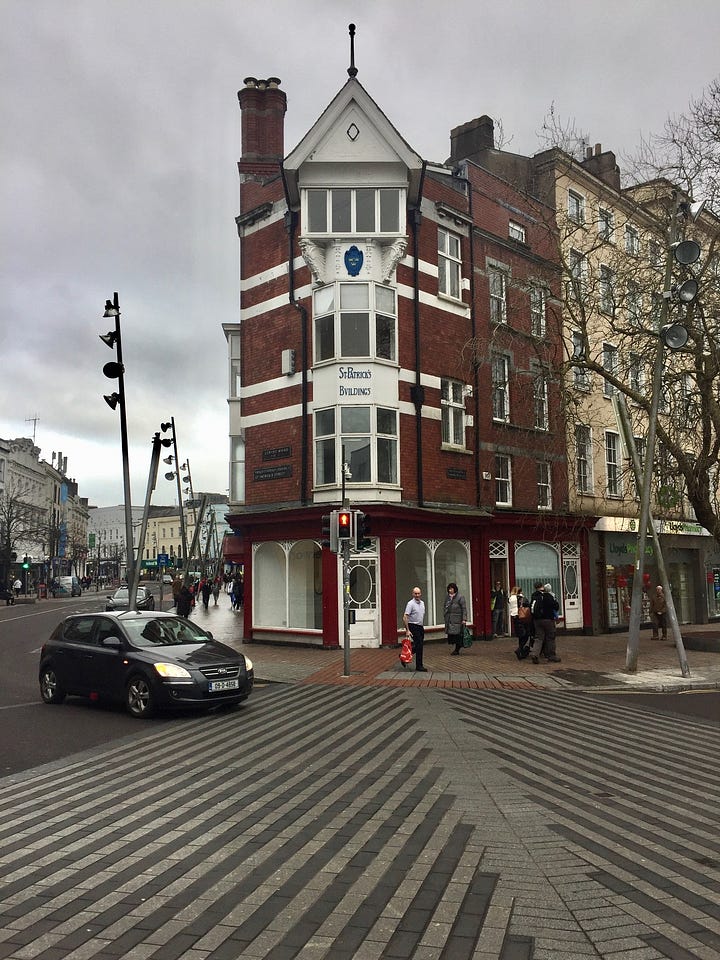

A go to street, or a go through street?
“Patrick’s Street is not a normal street,” Brendan O’Sullivan, director of the Centre for Planning Education and Research at UCC tells me over the phone. A resident of the city centre, Brendan spends a great deal of time in and around St Patrick’s Street and he has a great deal of affection for the street. A few minutes into our conversation he tells me about a much overlooked gem on the street: Seamus Murphy’s “dog bowl” secreted away near the entrance of a vacant shop building at the north end of St. Patrick's Street.
What Brendan means by “not normal” is not that the street is the preserve of weird or strange buildings and people, but that up until relatively recently it was a national road through which traffic coming from all points to the west headed for Dublin traversed through (and vice versa). Effectively, St. Patrick’s Street was a very busy main road, which also happened to be the city’s main street.
The Jack Lynch Tunnel has relieved it of this duty, but Patrick’s Street’s role in relation to traffic is an ongoing conversation, and the so-called “Pana ban” is probably as good a place as any to start.
The “Pana ban”
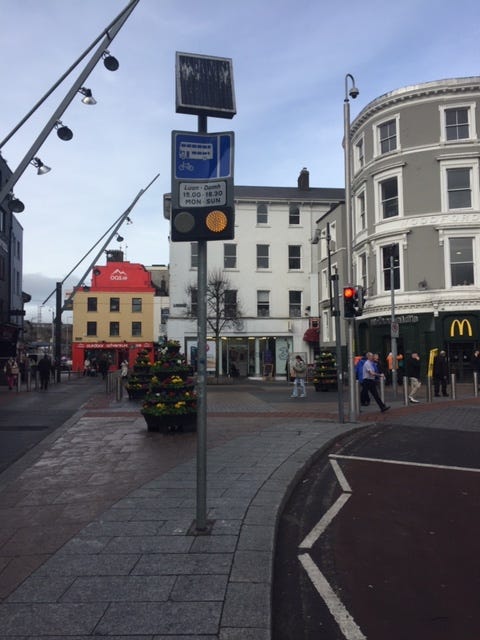
Introduced a few years ago, the “Pana ban” runs from 3pm-6:30pm, Monday through Saturday and applies to private cars: buses, bicycles, taxis and emergency vehicles can still go up and down the street, but private transport is meant to steer clear during these hours. There are signs on Grand Parade, Washington Street and Merchant’s Quay informing drivers of the restrictions.
On a recent Friday afternoon, I took up position outside Queens Old Castle just before 3pm to witness how the Pana ban works, or doesn’t, when the clock strikes three. And the short answer is it works, and doesn’t. Plenty of cars travelled up Grand Parade, obeyed the restriction and turned off onto Daunt Square. But for every law abiding driver, there were transgressors who sailed on through. The City Council doesn’t operate cameras to keep track of cars defying the ban, although drivers can be fined, if they are caught. Luckily for those who drove up and down Patrick’s Street on the day I was there, there was no police presence.
One unintended consequence of the so-called Pana ban is that it sends northbound drivers down the narrow road into Cornmarket Street, but also quite a few cars turn on to Paul Street and right into throngs of pedestrians. Whatever about cars going up and down Patrick’s Street, where the street is segregated, having cars and pedestrians mix on Paul Street makes little sense.
Also, at one stage a driver exiting Patrick’s Street (after 3pm) onto Grand Parade, made a snap decision, U-turned onto Daunt Square, but mistimed her maneuver, and so she ended up going backwards and forwards trying to get the car to line up with the narrow access road. All the while traffic backed up behind her, blocking buses from pulling in at the bus stops behind the wayward driver. Drivers are nothing if not entertaining. And other adjectives.
On the “Pana ban”, Helen Murphy, business and communications manager with Cork Business Association (CBA), a lobby group which represents retailers and businesses in the city, thinks that the future of travel in and out of the city is going to be far less reliant on private cars.
“We do have to move with the times and we do have to understand that the days of everybody being able to drive their car right into town and right down Patrick’s Street are really behind us at this point because we need to look at more sustainable transport options.”
Brendan O’Sullivan said that for drivers Patrick’s Street is becoming less of a “go to place” over time; the temporary traffic ban is helping in this regard. He also recognised that enforcement is problematic, as is getting the message out to drivers from outside of Cork who genuinely might not know there is a restriction in place.
Fearghal Reidy, director of strategic and economic development for Cork City Council, told me that the City Council has gone on record saying that there needs to be stronger adherence to the restrictions and stronger enforcement.
Fearghal pointed out that during and since the pandemic the council has taken significant steps to increase the number of pedestrianised streets in the city centre, as well as down at the Marina. The Council is putting the emphasis on making the city more pleasant and liveable for residents and visitors, he said.
“We would definitely, strongly ask for better adherence and better enforcement of the traffic regimes on Patrick’s Street,” Fearghal told T+D.
Throughout its two-century long existence, transport has always been contested on Patrick’s Street. Trams, horse and cart, bicycles, buses and private cars have all had their hey-day on the street, with the automobile winning the battle for the best part of the last 70 years. But cities are changing, and not just since and because of the pandemic. As Simon Kuper in The Financial Times wrote recently, early last century, cities made some fateful bad choices.
“Offered two new rival vehicles, they chose the gasoline-powered car over the clean, cheap and compact safety bicycle.” Furthermore, cars as well as offering a means to get into city centres, also helped push urban sprawl.
This is something which Patrick’s Street and Cork city centre is still dealing with, and any conversation about the future of the city centre invariably brings up what’s happening out in the suburbs, in the malls and shopping centres, the ones built and unbuilt, that are competing with the city centre. The biggest threats to St. Patrick's Street are arguably what’s happening well outside the city but online, where nearly anything can be purchased with just a few taps on your phone.
Better days ahead and one of the best views onto Pana

One of the best views of the northern end of Patrick’s Street has to be from the expansive first floor window in Fitzgerald Menswear near the corner of Winthrop Street. Eddie Mullins, the affable managing director, has been working at Fitzgerald’s for the past 22 years. It’s one of the oldest extant retailers on the street having first opened in 1860 and it’s been clothing generations of Cork men ever since.
When I dropped by this week for an interview Eddie showed me upstairs; I spent most of the time looking out the window at the uninterrupted view which stretches up the boulevard to Fr. Matthew and across Patrick’s Bridge befoe sweeping up Patrick’s Hill. It offers the kind of perfect people watching vista that's also incompatible with doing any work.
Eddie is hopeful about the future of Patrick’s Street and the city centre. He has to be; his life and business is invested in the street and the city centre, but he thinks the city council have done well on a few counts. He points out the window to the large planters which dot the street and are now blooming with flowers.
“The council have done well in holding firm against letting an avalanche of fast food places opening on the street. They’ve held the line and this is paying off,” he says, noting that Mango and Flannels, two well-known international brand names, are moving in across the way. Eddie also mentioned rumours about a development with the sale of Roches Stores. (I heard this rumour mentioned several times, but as of yet, there’s nothing concrete.)
Eddie says the core focus of those responsible for steering the city has to be on maintaining the city centre as a place to shop, visit, do business, eat, drink, be entertained, hang out and explore. And also to live in.
If not, Eddie says it leads to a hollowing out of city centres. Some of that is already playing out.
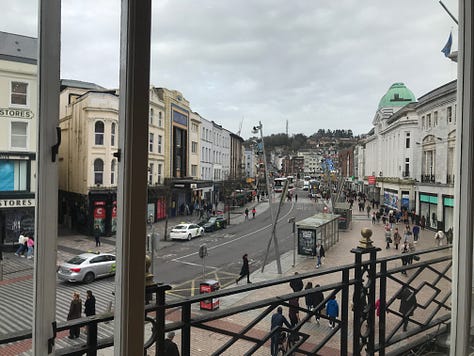
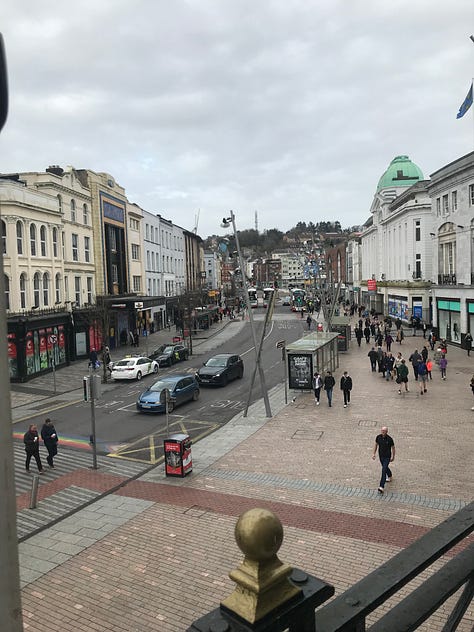
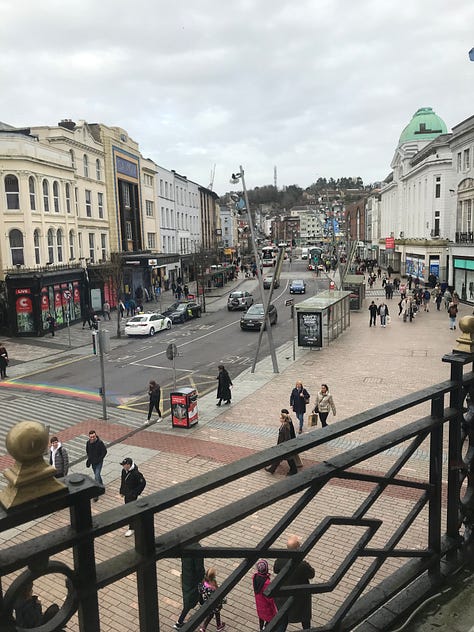
As Ellie reported last month on T+D, a recent report from Lisney, an auctioneer, found that just over one in five units on Cork city’s main thoroughfare is now vacant. Oliver Plunkett Street fares a little better, with 12% of its retail units vacant.
Eddie says that “sometimes it can be frustrating that you’re competing with the high cost of being on Patrick’s Street which comes with rates and mortgages and rents and sometimes if you go to the outskirts where businesses are paying different rates and rents and it’s not a fair playing ground.”
On the rents being charged on St Patrick’s Street, Eddie thinks there’s a bit of reality and a reset happening.
“There’s eye-watering rents being looked for in places and and there’s a bit of reality coming in and landlords are saying, ‘do we want an idol building or have someone in here who can trade?’”
Eddie recognises that the city centre shouldn’t be only about shops and shopping. Interestingly, he notes that Sunday - Fitzgerald’s is open seven days a week - is one of the best days of the week to visit the city centre.
“It’s a family day,” Eddie says. “People are more relaxed, they might go for lunch or brunch or coffee or ice-cream and there’s a special kind of atmosphere.”
Eddie is equal parts optimist and pragmatist: he acknowledges the way the council, Gardaí and the business community are working together to sustain the street, but likewise he said he would like to see more of a Garda presence on the street
He points out the issue of homelessness and people sleeping rough on the street. In a different vein, Eddie highlights how operating an independent business and keeping staff is hard, saying that he’s competing with the likes of Apple and other big employers, and also with changing mores and perceptions.
“The pity here is that sometimes everyone wants their sons and daughters to be solicitors and barristers and doctors and surgeons, but you see it in other countries where they cherish independent (businesses). Kids cherish it and look forward to going into business and I think that's one thing maybe that has changed over here, which is a pity,” Eddie said.
This is a point Fearghal Reidy at Cork City Council picked up and which the council emphasised in the Cork City Centre Revitalisation Action Plan, a 100-page blueprint drawn up last year which will guide how the council reactivates the city centre for the next three years.
Fearghal said in looking at other cities in Ireland and across Europe, one area where Cork city centre stood out is in the “level of proprietor-managed retailers and business which is a real draw.”
“They’re all unique and they make a place feel different compared with constant sameness,” Fearghal said.
That’s undeniably true: shopping in Joyce’s on Princes Street or Fitzgerald’s and Tracy Shoes on Patrick Street or popping into Nash 19 or Miyazaki is going to be a much different experience than dropping by McDonald’s or JD Sports.
“To that extent what we’re trying to do is work with retailers through the local enterprise office to provide them mentoring and support to continuously enhance their offering in retail and hospitality,” Fearghal said.
But, whether a small, family-run business or a young entrepreneur would ever be able to set up shop on Patrick’s Street given the cost of doing business there is debatable?
Back at Fitzgerald’s, with Eddie I’m surveying the street. The Gardaí have shown up to deal with an incident unfolding on the other side of the street. It’s a regular occurrence Eddie says. Below us, a man about my own age roots around in a bin; he looks to be in a bad way. Shoppers go by, passing up and down the street.
‘Are the best days ahead of us?’ I think they are,” Eddie said.
A new kid on the block
One of the most recent Irish-owned businesses to open on Patrick’s Street is Dubray Books, which has a handful of stores in and around Dublin. It opened on Patrick’s Street in November of 2021.
While Emma Shannon, the manager of Dubray Books on Patrick’s Street is from Dublin, she was a regular visitor to Cork and had telegraphed management well in advance of Dubray’s move to Cork that she’d like to run the ship down here if they ever made the move south.
“People were delighted to have something new on Patrick Street,” Emma said recalling Dubray’s opening on Patrick’s Street, particularly as it was a new bookshop and brought to the street a new store that wasn’t a clothes or vape shop or fast food outlet.
“We got a really nice warm welcome from everybody,” she added. Like Watersones, their nearby neighbours, Dubray has ingratiated itself to the street and the city with book launches: Adam and David King as well as art critic and writer Cristín Leach have all had book launches at the Dubray outpost on Patrick’s Street.
What’s transpired since Dubray opened is that there are now three book shops within shouting distance of each other on Patrick’s Street: Waterstones, Dubray and now Easons which occupies the ground floor of the old Victoria Hotel, which was beautifully reappointed by Youghal-based Ahern Bros. (Yay Cork, in its signature the bottle is overflowing outlook called the new Easons “fierce fancy.”)
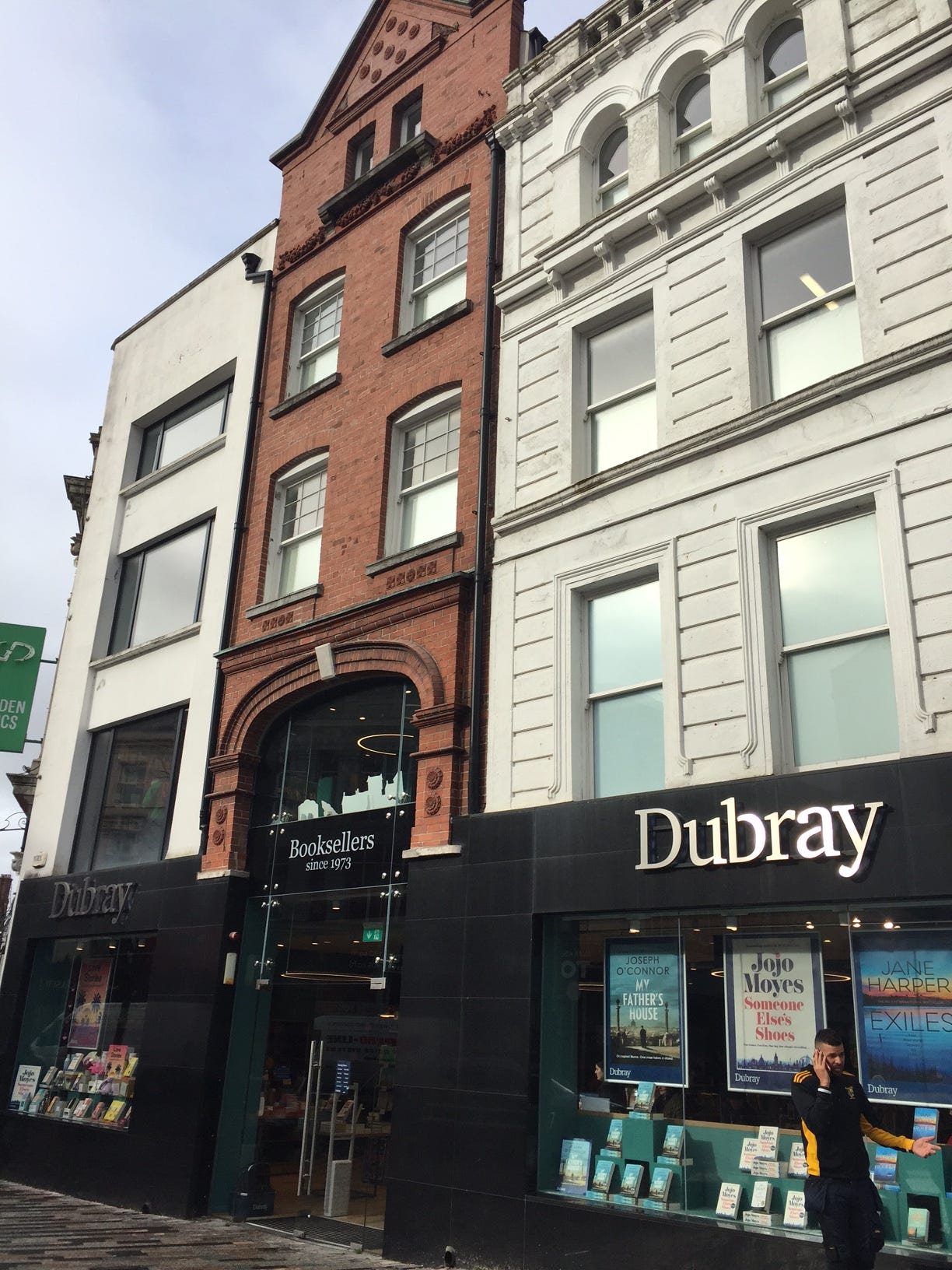
It’s not uncommon, Emma says, explaining the confederacy of book shops. As she said, each book shop has its own appeal. For Dubray, Emma said it’s the knowledge of books that the staff have, especially their staff recommendations. Emma’s email sign off alerts readers that she’s currently reading The Paper Man by Cork author Billy O’Callaghan.
Emma offers a good outsider’s perspective of St Patrick’s Street; while the street can feel a little samey and empty in places, given the level of vacancy on the street, what makes the street special is also the number of laneways and streets leading on and off the thoroughfare. Dubray is on the corner of Carey’s Lane, a narrow strip which leads up to Paul Street. As Emma points out she can disappear up the lane to grab a coffee in a jiffy. This is a point echoed by Eddie Mullins; Patrick’s Street is as much the streets that lead off and bleed onto it such as French Church Street, Carey’s Lane and Winthrop Street, where the bye-laws allow for outdoor dining.
Not O'Connell Street
One thing you’ll notice fairly quickly from strolling along Patrick’s Street is that it’s a street almost devoid of outdooring dining. This is owing to council bye-laws which put the emphasis on retail; bar The Chateau, an institution on the street, and Gino’s Gelato on the corner of Winthrop Street, there is no outdoor dining or drinking on the street.
Helen Murphy from CBA thinks that the bye-laws on St Patrick’s Street could do with a little tinkering to allow cafes with outdoor dining on the street.
“I do think that we do need to have just a little bit more on the cafe side,” Helen said. “Just even around the corners or something to bring (out) that vibrancy,” she said, adding that nearby Oliver Plunkett Street which ramped up its outdoor offerings has generated a great vibe.
Given how much space was allocated to pedestraianisation in the Beth Gali-led overhaul of St Patrick’s Street at the turn of the millennium, there certainly is space for outdoor dining on the street, if done right.
Helen thinks that a “careful realignment” of bye-laws would allow the street to reach its potential. By that she means allowing “cafes or hospitality type businesses” to open on the corners of Patrick’s Street such as at the building formerly occupied by Porters on the corner of Marlboro Street.
“I know there is a fear that if you have a free-for-all that it’ll turn into a fast food street a bit like O’Connell Street (in Dublin),” Helen said. “That’s not what we’re talking about.”
When I asked Fearghal Reidy, from the City Council, if the council were open to changing, or at least bending the bye-laws, he spoke about legal definitions, and about being careful to accommodate different uses and tastes as well as the city’s commitment to being a healthy city.
“But for sure we would want uses that maintain the quality of the offering in the city centre,” he said.
Given the CBA’s city focus, it’s not unsurprising that Helen said the lobby group is firmly not in favor of the proposal to build an outlet centre in Carrigtwohill, in east Cork. If it goes ahead, and that’s a big if, Helen thinks it would “not be good for Cork.”
“I think it goes against development plans,” she said, adding that “we need to maintain the primacy of the city centre as the main retail centre for Cork city and county.”
She said the CBA views the “retail village idea as a bit pastiche.”
“It doesn’t give either locals or tourists any flavour of what Cork has to offer whereas the city centre does that in spades. We have to be aware that the city needs protecting,” Helen said, adding that from a sustainability perspective it makes little sense to build an outlet centre that will likely be accessed predominantly by private transport.
Come sit down
One of the great unintended consequences of the “robo trees”, installed in 2021, was that they provided a place to sit down, and because of their size, a few people can comfortably sit together.
The renovation of Partrick’s Street 20 years ago took a severe approach to public seating; it gave us these large squat slabs and said if you must sit, do it on them. Really though the message was; shop and sayonara.
However the council, together with local partners has subsequently taken a more collaborative and compassionate approach to public seating. At nearly all times of the day, that is, when it’s not raining, the “robo tree” seats near French Church Street are occupied.
As Jeanette Fitzsimons, a planning lecturer in UCC told me by email, public seating in the city centre tends to be located in clusters.
“Ideally seating spread around the streets can benefit and increase confidence of people to move around the city as they are assured there is somewhere to rest at regular intervals,” Jeanette said.
Jeanette told me that planning students in UCC compile a public seating survey every year as part of their coursework and one of the findings particular to Patrick’s Street is that “public seating is all the northside/Paul Street side (sunnier side) and there is no public seating on the south side (shaded side) of the street.”
“I can understand why seating would be only on one side for climatic and sun reasons, however, for universal access and helping people’s mobility, there should be public seating on both sides of the street to allow places to rest,” Jeanette said.
Where the council have made amends and made use of the “Gali blocks” is a clever retrofit which turns them into public seats. Jeanette praised the project for its inclusive approach.
The retrofit “is a really interesting project, as it involved a very inclusive approach – with an age action community group doing a city walk about with city council staff (architects, social inclusion officer) along with an occupational therapist (Linda Horgan) who advised on retrofitting the existing seating to make them more inclusive – warmer materials, handrails, higher seat height,” Jeanette said.
Functional public seating is a small but significant intervention, and it’s a reminder to some of the councillors who routinely argue that anything that’s not commercial in nature is likely to lead to “anti-social” behaviour.
As Eddie Mullins of Fitzgerald Menswear told me, the seating slows things down on the street, giving people a chance to pause and rest up a while.
The nice things about Patrick Street
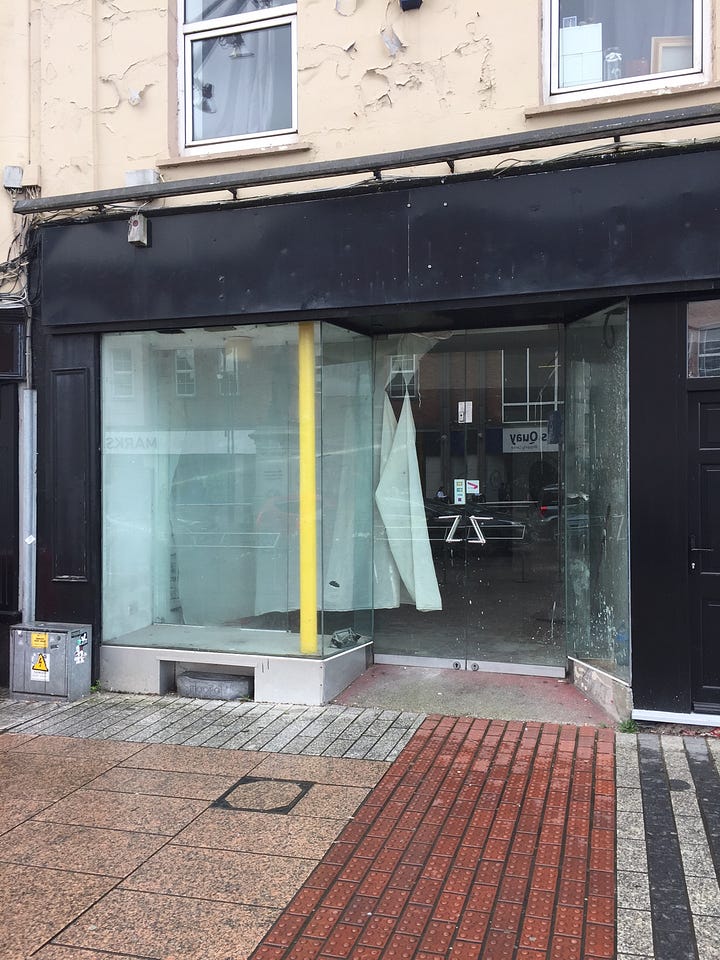
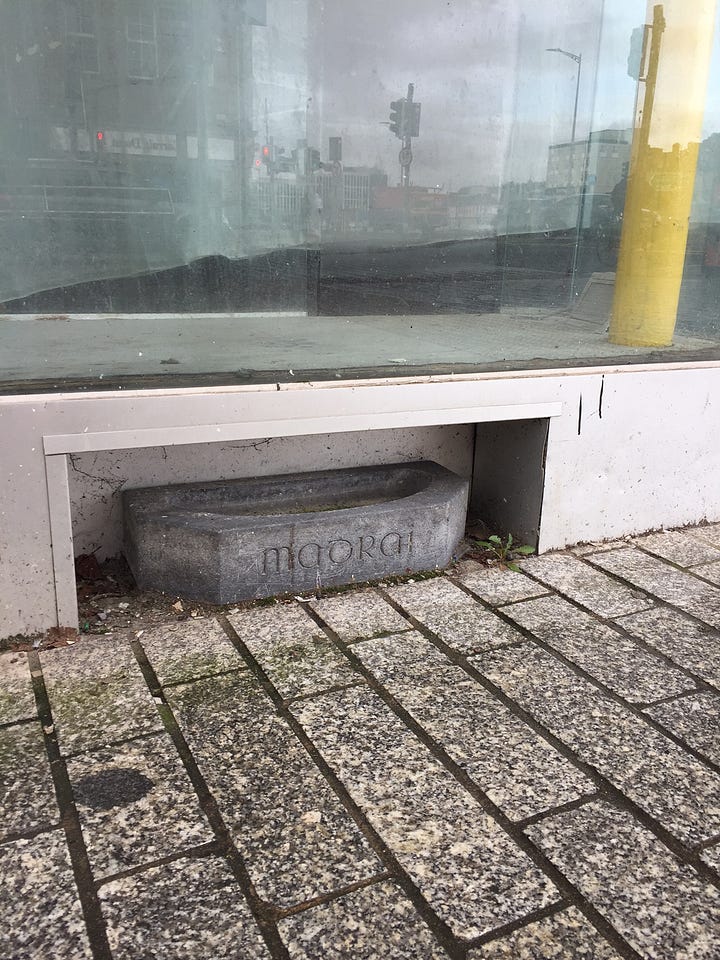
It’s easy to get caught up in all that’s not quite working with St Patrick’s Street (hello vacancy and dereliction, the sometimes slippery surface of the street and why are Eir and The Chateau allowed to cover the facade of their buildings in advertising?) but Patrick’s Street has got some things right. And it has, as everyone I spoke with for this piece agreed, plenty in the way of potential.
Inevitably what happens on Patrick’s Street is that you meet people you know, or haven’t met in ages. The Friday afternoon I spent walking up and down I met two people I hadn’t bumped into in years; in fact one of them was a city council worker I had emailed to ask about Patrick’s Street. Cork is that kind of city, and Patrick’s Street is definitely that kind of street.
It’s a vibrant street as Brendan O’Sullivan points out. And slowly but surely some of the spotlight is being put back on the architecture on the street, such as with the old Victoria hotel, where the second ever meeting of the nascent GAA took place. There’s a plaque on the wall commemorating that fact. It’s the only main street in the world that I know of with a dog trough, and created by one of our most famous sculptors. I’m talking of the trough at the north end of the Street bearing the Irish word for dogs ‘Madraí’, which was sculpted by Seamus Murphy and is located under the window of a vacant shop across the way from Fr. Matthew.
On the other side of the street across the way from Fr. Matthew, Mangan’s Clock will soon be up and running. And this week the City Council confirmed that consultants have (finally) examined the old bus driver’s ‘hut’ which stood for decades behind Fr. Matthew. In one sense, history might be the best guide of all in steering a path for Patrick’s Street.
For centuries, the street was a car-free zone, and it’s heading that way again to some degree at least when it comes to private cars. It’s always been a street where commerce thrived, and many times failed, but nonetheless it’s been an incubator. Likewise, all manner of political rallies, celebrations and religious gatherings have unfolded on the street. And in parts the street has risen from the ashes owing to its destruction as a result of the burning of Cork 100 years ago. Exorbitant rents and the digital economy are a clear and present danger for St. Patrick’s Street. But it’s a historic street built on resilience as much as it is with tarmacadam and concrete. There’s a recognition that Patrick’s Street, and the city centre, have to change to stay alive and to stay relevant.
The Pana shuffle isn’t over yet.
Note: For those interested in a thorough read about the history of St. Patrick’s Street Antoin O'Callaghan’s book “Cork's St Patrick's Street: A History Hardcover” published in 2011 and available in the City library is an excellent play to start.




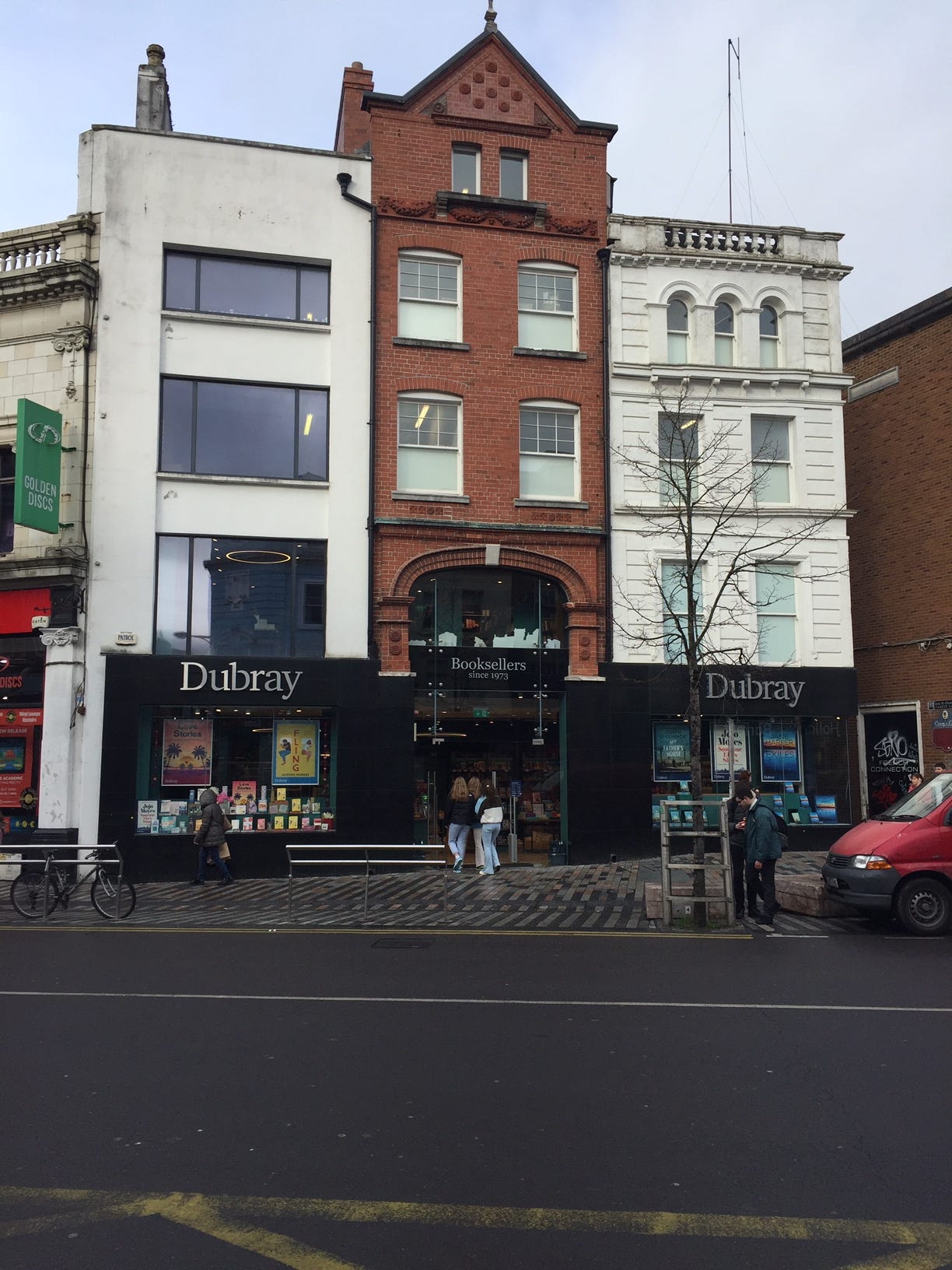
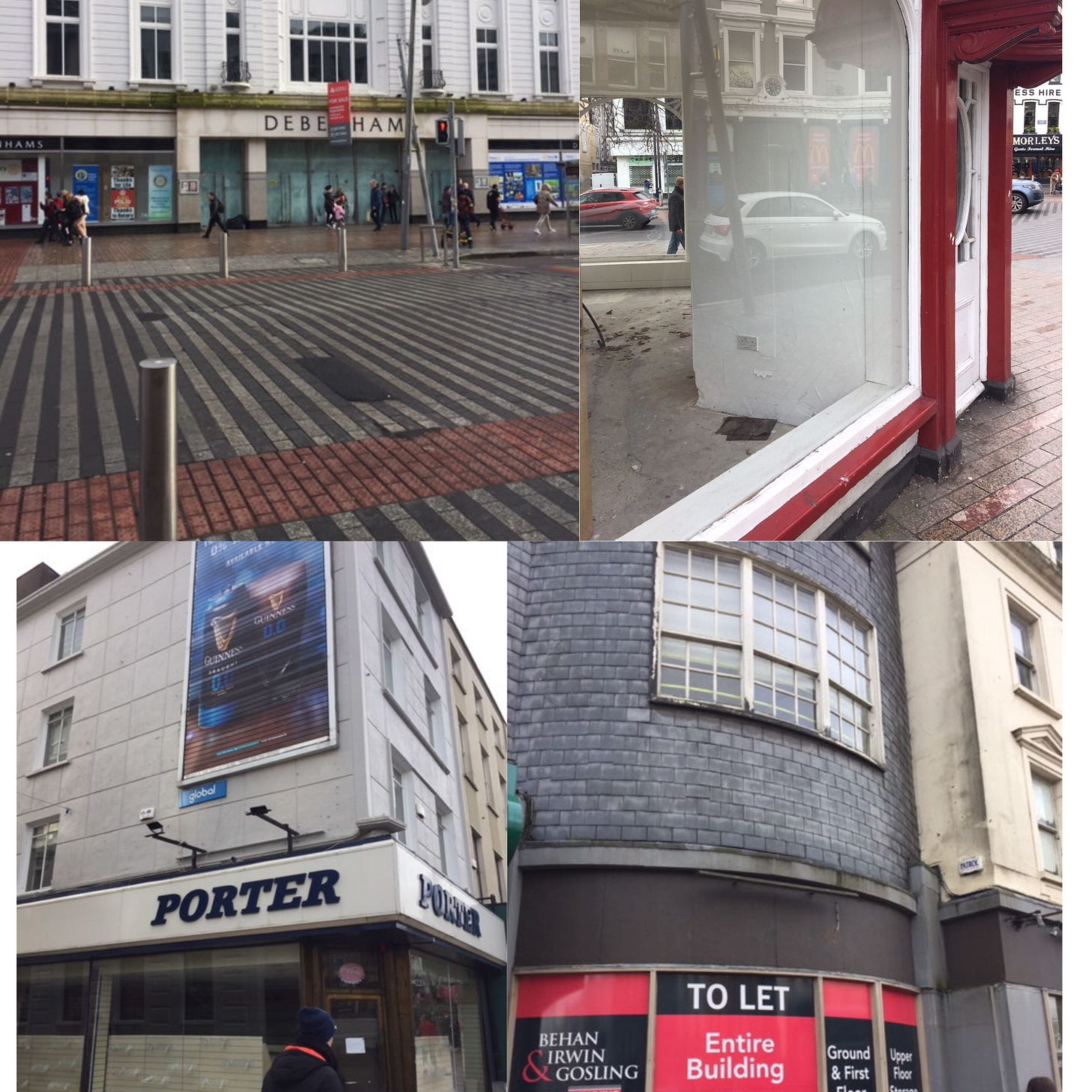




maybe I've said this before but if I was ye, I'd give a free subscription to Shane Lehane in Coláiste Stiophán Naofa, starting with the Pana article and three months later I'd write to him with an outline of topics which would be included in a CSN course in Investigative Journalism to launch in Sept 2024. With ye as visiting lecturers , or more.
Good article!